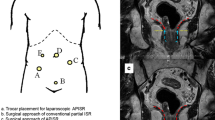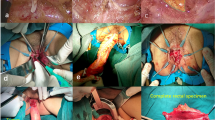Abstract
Background
The aim of this study was to compare the functional and oncologic results of pull-through intersphincteric stapled transection and anastomosis (PISTA) with low anterior resection (LAR) in the treatment for early ultralow rectal cancer.
Methods
A total of 278 patients with early ultralow rectal cancer were retrospectively included and analyzed, with 136 in the PISTA group and 142 in the LAR group.
Results
Gender, age, tumor diameter, distance from the dentate line to the inferior margin of the tumor, tumor stage, length of operation and postoperative complications were comparable in the two groups. Compared with the LAR group, the PISTA group had a more accurate distal transection site, a lower daily fecal frequency (6 (5–7) vs. 8 (7–9), p < 0.001) and a lower Wexner incontinence score (13 (10–14) vs. 14 (13–16), p < 0.001) 3 months after ileostomy reversal, and a higher rate of satisfactory fecal continence (97.1 % vs. 90.8 %, p = 0.043). The follow-up period of the PISTA group was similar to that of the LAR group (56 (30–81) months vs. 54 (30–80) months, p = 0.982). The PISTA group was associated with a lower local recurrence rate (2.2 % vs. 11.3 %, p = 0.003). Kaplan–Meier analysis also showed that the PISTA group was associated with longer overall survival (p = 0.018) and longer local recurrence-free survival (p = 0.004) than the LAR group, while distant metastasis-free survival (p = 0.896) was comparable in the two groups. Multivariate analysis identified lymph node metastasis (p < 0.001) and operation (PISTA vs. LAR, p = 0.031) as independent predictive factors for local recurrence-free survival.
Conclusions
PISTA is a technically simple, oncologically safe and functionally favorable procedure for the treatment for early ultralow rectal cancer.



Similar content being viewed by others
References
Han JG, Wei GH, Gao ZG, Zheng Y, Wang ZJ (2009) Intersphincteric resection with direct coloanal anastomosis for ultralow rectal cancer: the experience of People’s Republic of China. Dis Colon Rectum 52:950–957
Williams NS, Dixon MF, Johnston D (1983) Reappraisal of the 5 centimetre rule of distal excision for carcinoma of the rectum: a study of distal intramural spread and of patients’ survival. Br J Surg 70:150–154
Tjandra JJ, Kilkenny JW, Buie WD et al (2005) Practice parameters for the management of rectal cancer (revised). Dis Colon Rectum 48:411–423
Dai Y, Jiang JB, Bi DS, Jin ZT, Sun JZ, Hu SY (2008) Preservation of the continence function after intersphincteric resection using a prolapsing technique in the patients with low rectal cancer and its clinical prognosis. Chin Med J 121:2016–2020
Schiessel R, Karner-Hanusch J, Herbst F, Teleky B, Wunderlich M (1994) Intersphincteric resection for low rectal tumours. Br J Surg 81:1376–1378
Schiessel R, Novi G, Holzer B et al (2005) Technique and long-term results of intersphincteric resection for low rectal cancer. Dis Colon Rectum 48:1858–1865
Hohenberger W, Merkel S, Matzel K, Bittorf B, Papadopoulos T, Göhl J (2006) The influence of abdomino-peranal (intersphincteric) resection of lower third rectal carcinoma on the rates of sphincter preservation and locoregional recurrence. Colorectal Dis 8:23–33
Yamada K, Ogata S, Saiki Y, Fukunaga M, Tsuji Y, Takano M (2009) Long-term results of intersphincteric resection for low rectal cancer. Dis Colon Rectum 52:1065–1071
Jorge JM, Wexner SD (1993) Etiology and management of fecal Incontinence. Dis Colon Rectum 36:77–97
Bennett RS (1976) The place of pull-through operations in treatment of carcinoma of the rectum. Dis Colon Rectum 19:420–424
Fu CG, Muto T, Masaki T (1997) Results of the double stapling procedure in colorectal surgery. Surg Today 27:706–709
Ito M, Saito N, Sugito M, Kobayashi A, Nishizawa Y, Tsunoda Y (2009) Analysis of clinical factors associated with anal function after intersphincteric resection for very low rectal cancer. Dis Colon Rectum 52:64–70
Rasmussen OO, Petersen IK, Christiansen J (2003) Anorectal function following low anterior resection. Colorectal Dis 5:258–261
Amin AI, Hallböök O, Lee AJ, Sexton R, Moran BJ, Heald RJ (2003) A 5-cm colonic J pouch colo-anal reconstruction following anterior resection for low rectal cancer results in acceptable evacuation and continence in the long term. Colorectal Dis 5:33–37
Chude GG, Rayate NV, Patris V et al (2008) Defunctioning loop ileostomy with low anterior resection for distal rectal cancer: should we make an ileostomy as a routine procedure? A prospective randomized study. Hepatogastroenterology 55:1562–1567
Wang HT, Gao XH, Fu CG, Wang L, Meng RG, Liu LJ (2010) Diagnosis and treatment of diffuse cavernous hemangioma of the rectum: report of 17 cases. World J Surg 34:2477–2486
Acknowledgments
This study was supported by the National Nature Science Fund of China, No. 30973460, No. 81201936, No. 81272561.
Conflict of interest
The authors declare that no conflict of interest exists.
Author information
Authors and Affiliations
Corresponding author
Rights and permissions
About this article
Cite this article
Fu, C.G., Gao, X.H., Wang, H. et al. Treatment for early ultralow rectal cancer: pull-through intersphincteric stapled transection and anastomosis (PISTA) versus low anterior resection. Tech Coloproctol 17, 283–291 (2013). https://doi.org/10.1007/s10151-012-0919-1
Received:
Accepted:
Published:
Issue Date:
DOI: https://doi.org/10.1007/s10151-012-0919-1




